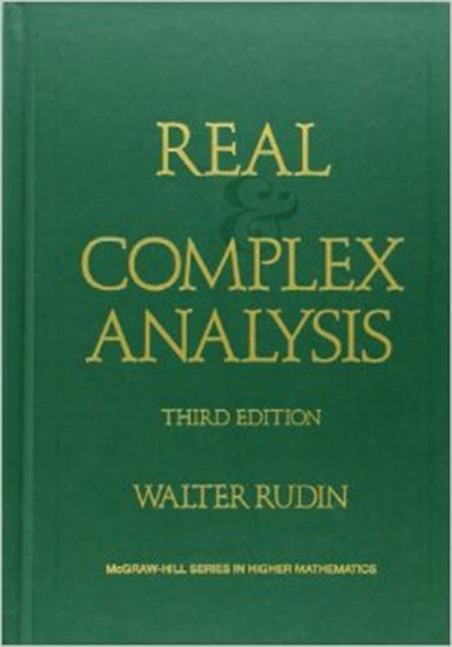
Zustellung: Sa, 07.06. - Sa, 14.06.
Versand in 3-4 Wochen
VersandkostenfreiBestellen & in Filiale abholen:
This is an advanced text for the one- or two-semester course in analysis taught primarily to math, science, computer science, and electrical engineering majors at the junior, senior or graduate level. The basic techniques and theorems of analysis are presented in such a way that the intimate connections between its various branches are strongly emphasized. The traditionally separate subjects of 'real analysis' and 'complex analysis' are thus united in one volume. Some of the basic ideas from functional analysis are also included. This is the only book to take this unique approach. The third edition includes a new chapter on differentiation. Proofs of theorems presented in the book are concise and complete and many challenging exercises appear at the end of each chapter. The book is arranged so that each chapter builds upon the other, giving students a gradual understanding of the subject. This text is part of the Walter Rudin Student Series in Advanced Mathematics.
Inhaltsverzeichnis
< H3> Preface< H3> Prologue: The Exponential Function< H3> Chapter 1: Abstract Integration< H4> Set-theoretic notations and terminology< H4> The concept of measurability< H4> Simple functions< H4> Elementary properties of measures< H4> Arithmetic in [0, 8]< H4> Integration of positive functions< H4> Integration of complex functions< H4> The role played by sets of measure zero< H4> Exercises< H3> Chapter 2: Positive Borel Measures< H4> Vector spaces< H4> Topological preliminaries< H4> The Riesz representation theorem< H4> Regularity properties of Borel measures< H4> Lebesgue measure< H4> Continuity properties of measurable functions< H4> Exercises< H3> Chapter 3: Lp-Spaces< H4> Convex functions and inequalities< H4> The Lp-spaces< H4> Approximation by continuous functions< H4> Exercises< H3> Chapter 4: Elementary Hilbert Space Theory< H4> Inner products and linear functionals< H4> Orthonormal sets< H4> Trigonometric series< H4> Exercises< H3> Chapter 5: Examples of Banach Space Techniques< H4> Banach spaces< H4> Consequences of Baire's theorem< H4> Fourier series of continuous functions< H4> Fourier coefficients of L1-functions< H4> The Hahn-Banach theorem< H4> An abstract approach to the Poisson integral< H4> Exercises< H3> Chapter 6: Complex Measures< H4> Total variation< H4> Absolute continuity< H4> Consequences of the Radon-Nikodym theorem< H4> Bounded linear functionals on Lp< H4> The Riesz representation theorem< H4> Exercises< H3> Chapter 7: Differentiation< H4> Derivatives of measures< H4> The fundamental theorem of Calculus< H4> Differentiable transformations< H4> Exercises< H3> Chapter 8: Integration on Product Spaces< H4> Measurability on cartesian products< H4> Product measures< H4> The Fubini theorem< H4> Completion of product measures< H4> Convolutions< H4> Distribution functions< H4> Exercises< H3> Chapter 9: Fourier Transforms< H4> Formal properties< H4> The inversion theorem< H4> The Plancherel theorem< H4> The Banach algebra L1< H4> Exercises< H3> Chapter 10: Elementary Properties of Holomorphic Functions< H4> Complex differentiation< H4> Integration over paths< H4> The local Cauchy theorem< H4> The power series representation< H4> The open mapping theorem< H4> The global Cauchy theorem< H4> The calculus of residues< H4> Exercises< H3> Chapter 11: Harmonic Functions< H4> The Cauchy-Riemann equations< H4> The Poisson integral< H4> The mean value property< H4> Boundary behavior of Poisson integrals< H4> Representation theorems< H4> Exercises< H3> Chapter 12: The Maximum Modulus Principle< H4> Introduction< H4> The Schwarz lemma< H4> The Phragmen-Lindelö f method< H4> An interpolation theorem< H4> A converse of the maximum modulus theorem< H4> Exercises< H3> Chapter 13: Approximation by Rational Functions< H4> Preparation< H4> Runge's theorem< H4> The Mittag-Leffler theorem< H4> Simply connected regions< H4> Exercises< H3> Chapter 14: Conformal Mapping< H4> Preservation of angles< H4> Linear fractional transformations< H4> Normal families< H4> The Riemann mapping theorem< H4> The class L< H4> Continuity at the boundary< H4> Conformal mapping of an annulus< H4> Exercises< H3> Chapter 15: Zeros of Holomorphic Functions< H4> Infinite Products< H4> The Weierstrass factorization theorem< H4> An interpolation problem< H4> Jensen's formula< H4> Blaschke products< H4> The Mü ntz-Szas theorem< H4> Exercises< H3> Chapter 16: Analytic Continuation< H4> Regular points and singular points< H4> Continuation along curves< H4> The monodromy theorem< H4> Construction of a modular function< H4> The Picard theorem< H4> Exercises< H3> Chapter 17: Hp-Spaces< H4> Subharmonic functions< H4> The spaces Hp and N< H4> The theorem of F. and M. Riesz< H4> Factorization theorems< H4> The shift operator< H4> Conjugate functions< H4> Exercises< H3> Chapter 18: Elementary Theory of Banach Algebras< H4> Introduction< H4> The invertible elements< H4> Ideals and homomorphisms< H4> Applications< H4> Exercises< H3> Chapter 19: Holomorphic Fourier Transforms< H4> Introduction< H4> Two theorems of Paley and Wiener< H4> Quasi-analytic classes< H4> The Denjoy-Carleman theorem< H4> Exercises< H3> Chapter 20: Uniform Approximation by Polynomials< H4> Introduction< H4> Some lemmas< H4> Mergelyan's theorem< H4> Exercises< H3> Appendix: Hausdorff's Maximality Theorem< H3> Notes and Comments< H3> Bibliography< H3> List of Special Symbols< H3> Index
Produktdetails
Erscheinungsdatum
01. Mai 1986
Sprache
englisch
Auflage
3rd Revised edition
Seitenanzahl
432
Autor/Autorin
Walter Rudin
Verlag/Hersteller
Produktart
gebunden
Gewicht
771 g
Größe (L/B/H)
242/170/29 mm
ISBN
9780070542341
Bewertungen
0 Bewertungen
Es wurden noch keine Bewertungen abgegeben. Schreiben Sie die erste Bewertung zu "Real and Complex Analysis" und helfen Sie damit anderen bei der Kaufentscheidung.










